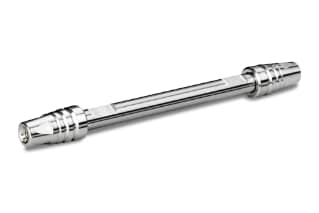
|
Chemistry |
C18 |
|
Separation Mode |
Reversed Phase |
|
Particle Substrate |
Silica |
|
pH Range Min |
2 pH |
|
pH Range Max |
8 pH |
|
Temperature Limits |
45 C |
|
Maximum Pressure |
18000 psi (1240 Bar) |
|
Endcapped |
Yes |
|
Bonding Technology |
C18+ |
|
Silanol Activity |
Low |
|
Particle Shape |
Spherical |
|
Particle Size |
2.7 µm |
|
Endfitting Type |
Parker-style |
|
Pore Size |
90 Å |
|
Format |
Method Validation Kit |
|
Surface Area |
100 |
|
System |
HPLC |
|
Particle Technology |
Solid Core |
|
USP Classification |
L1 |
|
Inner Diameter |
3 mm |
|
Length |
100 mm |
|
Carbon Load |
5.7 % |
|
eCord |
Yes |
|
UNSPSC |
41115709 |
|
Brand |
CORTECS |
|
Product Type |
Column Kits |
|
Units per Package |
3 pk |

CORTECS C18+ Method Validation Kit, 90Å, 2.7 µm, 3 mm X 100 mm, 3/pk
CORTECS C18+ columns are high-efficiency charged-surfaced C18 columns that provide excellent peak shape for basic analytes at low pH. For faster separations and higher throughput, use the CORTECS C18+ Column. The CORTECS C18+ Method Validation Kit includes three CORTECS C18+ Columns with varying chemistries. At low pH, a high-efficiency reversed-phase column with a positively charged surface produces an excellent peak shape for basic compounds. Scientists appreciate the C18 ligand in the CORTECS C18+ Column because of its high retention and stability.
When compared to the original separation, the CORTECS C18+ Column allows for a shorter column length while maintaining identical peak capacities and delivering faster re-equilibration durations. You can reduce lab operation costs by running more samples in parallel without affecting separation performance. Furthermore, simply increasing the approach's flow rate allows you to increase sample throughput while maintaining or exceeding peak capacity. The column is an important piece of scientific equipment because it allows you to resolve complex mixtures or maintain resolution while increasing throughput.
The CORTECS Solid Core C18+ Column is composed of solid-core particles that improve performance by lowering each of the three terms of the van Deemter equation. The A term decreases as the solid core particles pack more uniformly. Because the particle porosity of the solid core particles is lower, axial diffusion and, thus, the B term are reduced. Their solid core improves heat transmission and reduces radial temperature gradients, which results in a lower C term.
The CORTECS C18+ Column has a high-resolution selectivity. Please visit our website to learn more about the chemistry of the CORTECS C18+ Column and its various variations. It also allows you to shop for lab equipment and includes our entire product line to meet your analytical requirements.
You might also be interested in Neutrals QC Reference Material, which can be used in any chromatographic system with a UV detector. It is meant to serve as a system benchmarking standard. The mixture only contains neutral substances. The QC Reference Material, when used regularly and with control charts, will give you confidence in your results, reduce troubleshooting and rerun time, and allow you to compare results from multiple laboratories.
What Effect Does Temperature Have on Liquid Chromatography?
Chromatography is a series of equilibrium reactions in which analytes are either dissolved in the mobile phase or adsorbed to the stationary phase of the column. The exchange of analytes between the mobile phase and the stationary phase accelerates as the temperature rises. As a result, higher temperatures hasten the analysis.